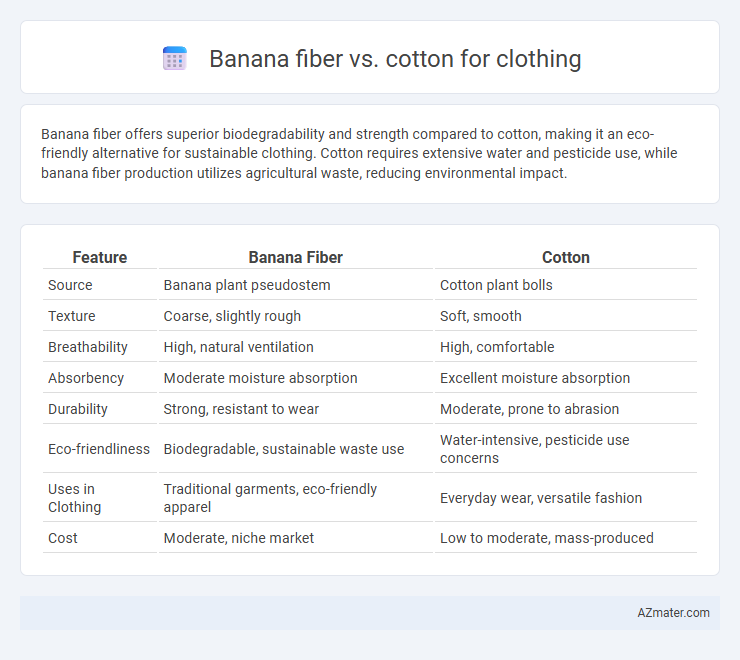Banana fiber offers superior biodegradability and strength compared to cotton, making it an eco-friendly alternative for sustainable clothing. Cotton requires extensive water and pesticide use, while banana fiber production utilizes agricultural waste, reducing environmental impact.
Table of Comparison
| Feature | Banana Fiber | Cotton |
|---|---|---|
| Source | Banana plant pseudostem | Cotton plant bolls |
| Texture | Coarse, slightly rough | Soft, smooth |
| Breathability | High, natural ventilation | High, comfortable |
| Absorbency | Moderate moisture absorption | Excellent moisture absorption |
| Durability | Strong, resistant to wear | Moderate, prone to abrasion |
| Eco-friendliness | Biodegradable, sustainable waste use | Water-intensive, pesticide use concerns |
| Uses in Clothing | Traditional garments, eco-friendly apparel | Everyday wear, versatile fashion |
| Cost | Moderate, niche market | Low to moderate, mass-produced |
Introduction to Banana Fiber and Cotton
Banana fiber, derived from the pseudostem of banana plants, is a sustainable and biodegradable textile known for its strength, durability, and natural sheen, making it an eco-friendly alternative to traditional fabrics. Cotton, a widely-used natural fiber obtained from the seed hairs of the cotton plant, is prized for its softness, breathability, and moisture absorption, which contribute to its dominance in the global textile industry. Both fibers offer unique benefits for clothing, with banana fiber emphasizing sustainability and durability, while cotton focuses on comfort and versatility.
Historical Background of Banana Fiber and Cotton
Banana fiber, derived from the pseudostem of banana plants, has been used for centuries in regions like Japan and India for traditional textiles, valued for its strength and eco-friendliness. Cotton, cultivated for over 7,000 years, has played a central role in global textile industries, especially prominent in ancient civilizations such as the Indus Valley and Egypt. Both fibers have rich histories that reflect their cultural significance and evolving applications in sustainable fabric production.
Environmental Impact: Banana Fiber vs Cotton
Banana fiber production significantly reduces water consumption compared to cotton, which requires extensive irrigation and contributes to water scarcity. Banana fibers are biodegradable and derived from agricultural waste, minimizing landfill contributions, whereas cotton farming involves heavy pesticide use and chemical fertilizers that degrade soil health. The lower carbon footprint of banana fiber processing, combined with its renewable and sustainable sourcing, positions it as an eco-friendly alternative to conventional cotton textiles.
Production Process Comparison
Banana fiber production for clothing involves extracting fibers from the banana plant's pseudo-stem through retting, stripping, and drying, resulting in a sustainable and eco-friendly process with minimal chemical use. Cotton production requires extensive water consumption and chemical treatments during cultivation and ginning to separate fibers, contributing to a higher environmental footprint. The banana fiber production process is generally more sustainable, utilizing agricultural waste and reducing reliance on intensive water and pesticide inputs compared to cotton.
Durability and Longevity in Clothing
Banana fiber exhibits exceptional durability due to its long, strong cellulose strands, making it highly resistant to wear and tear compared to cotton. Cotton fibers, while soft and breathable, tend to degrade faster with frequent washing and exposure to sunlight, reducing garment longevity. Choosing banana fiber for clothing ensures enhanced fabric strength and prolonged lifespan, ideal for sustainable fashion seeking durability.
Comfort and Breathability Differences
Banana fiber offers superior breathability compared to cotton due to its natural hollow structure, which enhances air circulation and moisture-wicking properties, making it ideal for hot and humid climates. Cotton provides a soft, smooth texture that many find comfortable for everyday wear, but it tends to retain moisture longer, potentially reducing comfort during intense physical activity. The rigidity of banana fiber can create a slightly coarser feel, yet its durability and eco-friendly attributes provide distinct advantages over traditional cotton fabrics.
Cost and Accessibility
Banana fiber offers a sustainable and eco-friendly alternative to cotton, often at a higher production cost due to limited large-scale manufacturing facilities. Cotton remains more accessible and cost-effective globally, benefiting from established supply chains and widespread cultivation. However, banana fiber's durability and biodegradability appeal to niche markets seeking sustainable fashion solutions despite its premium price.
Fashion and Design Possibilities
Banana fiber offers unique texture and durability, making it an innovative alternative to cotton in fashion design, especially for sustainable and eco-friendly collections. Its natural sheen and stiffness provide structure for avant-garde garments and accessories, while cotton remains preferred for its softness and versatility in casual and high-end apparel. Designers leverage banana fiber's biodegradability and strength to create distinctive, eco-conscious fashion pieces that stand out from traditional cotton fabrics.
Sustainability and Ethical Considerations
Banana fiber, derived from the pseudostem of banana plants, offers a sustainable alternative to cotton by utilizing agricultural waste and requiring less water and pesticides during production. Cotton cultivation is resource-intensive, often leading to soil degradation and high water consumption, raising ethical concerns about environmental impact and labor conditions. Choosing banana fiber clothing supports eco-friendly practices and fair trade initiatives, promoting both sustainability and ethical responsibility in the textile industry.
Future Trends in Eco-Friendly Textiles
Banana fiber offers a sustainable alternative to conventional cotton in eco-friendly textiles, boasting high tensile strength and biodegradability that align with circular fashion principles. Innovations in banana fiber processing are enhancing softness and durability, making it increasingly competitive for mainstream clothing production. Growing consumer demand for environmentally responsible fabrics is driving research and investment toward scalable, low-impact banana fiber textiles, positioning them as a key material in the future of sustainable fashion.

Infographic: Banana fiber vs Cotton for Clothing
 azmater.com
azmater.com